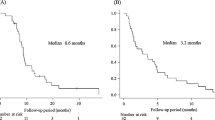Abstract
Nausea and vomiting may occur in a significant minority of patients following hepatic artery embolization with yttrium-90 spheres (K. T. Sato et al. Radiology 247:507–515, 2008). This encumbers human and economic resources and undercuts the assertion that it is as a well-tolerated outpatient treatment. A single intravenous dose of palonosetron HCl was administered before hepatic artery embolization with yttrium-90 spheres to ameliorate posttreatment nausea and vomiting, in 23 consecutive patients. The patients were discharged the day of procedure on oral antiemetics, steroids, and blockers of gastric acid release. All patients had clinical and laboratory evaluation at 2 weeks after the procedure. The data were gathered and reviewed retrospectively. At 2-week follow-up, none reported significant nausea, vomiting, additional antiemetic use, need for parenteral therapy, hospital readmission, or palonosetron-related side effects. All patients recovered from postembolization symptoms within a week after treatment. In conclusion, this retrospective study suggests that single-dose palonosetron is feasible, safe, and effective for acute and delayed nausea and vomiting in this group of patients. The added cost may be offset by benefits.
Similar content being viewed by others
References
El-Serag HB, Davila JA, Petersen NJ et al (2003) The continuing increase in the incidence of hepatocellular carcinoma in the United States: an update. Ann Intern Med 139(10):817–823
Kennedy AS, Coldwell D, Nutting C et al (2006) Resin 90Y-microsphere brachytherapy for unresectable colorectal liver metastases: modern USA experience. Int J Radiat Oncol Biol Phys 65(2):412–425
Aapro MS, Grunberg SM, Manikhas GM et al (2006) A phase III, double-blind, randomized trial of palonosetron compared with ondansetron in preventing chemotherapy-induced nausea and vomiting following highly emetogenic chemotherapy. Ann Oncol 17(9):1441–1449
Gralla R, Lichinitser M, Van Der Vegt S et al (2003) Palonosetron improves prevention of chemotherapy-induced nausea and vomiting following moderately emetogenic chemotherapy: results of a double-blind randomized phase III trial comparing single doses of palonosetron with ondansetron. Ann Oncol 14(10):1570–1577
Murthy R, Nunez R, Szklaruk J et al (2005) Yttrium–90 microsphere therapy for hepatic malignancy: devices, indications, technical considerations, and potential complications. Radiographics 5(Suppl 1):S41–S55
Kennedy A, Nag S, Salem R et al (2007) Recommendations for radioembolization of hepatic malignancies using yttrium-90 microsphere brachytherapy: a consensus panel report from the radioembolization brachytherapy oncology consortium. Int J Radiat Oncol Biol Phys 68(1):13–23
Sato KT, Lewandowski RJ, Mulcahy MF et al (2008) Unresectable chemorefractory liver metastases: radioembolization with 90Y microspheres-safety, efficacy, and survival. Radiology 247(2):507–515
de Boer-Dennert M, de Wit R, Schmitz PI et al (1997) Patient perceptions of the side-effects of chemotherapy: the influence of 5HT3 antagonists. Br J Cancer 76(8):1055–1061
Tarricone R, Girolami F (2005) Economic evaluation of a new antiemetic drug—palonosetron versus ondansetron: assessment of the drug price ratio in five European countries. Clin Drug Invest 25(9):597–608
Geling O, Eichler HG (2005) Should 5-hydroxytryptamine-3 receptor antagonists be administered beyond 24 hours after chemotherapy to prevent delayed emesis? Systematic re-evaluation of clinical evidence and drug cost implications. J Clin Oncol 23(6):1289–1294
Navari RM (2006) Palonosetron: a second-generation 5-hydroxytryptamine receptor antagonist. Future Oncol 2(5):591–602
Eisenberg P, Figueroa-Vadillo J, Zamora R et al (2003) Improved prevention of moderately emetogenic chemotherapy-induced nausea and vomiting with palonosetron, a pharmacologically novel 5-HT3 receptor antagonist: results of a phase III, single-dose trial versus dolasetron. Cancer 98(11):2473–2482
MASCC guidelines. Available at: http://www.mascc.org/media/Resource_centers/MASCC_Guidelines_Update.pdf
NCCN guidelines. Available at: http://www.nccn.org/professionals/physician_gls/PDF/antiemesis.pdf
Author information
Authors and Affiliations
Corresponding author
Rights and permissions
About this article
Cite this article
Siddiqi, N.H., Khan, A.J. & Devlin, P.M. Palonosetron—A Single-Dose Antiemetic Adjunct for Hepatic Artery Radioembolization: A Feasibility Study. Cardiovasc Intervent Radiol 32, 47–51 (2009). https://doi.org/10.1007/s00270-008-9428-z
Received:
Revised:
Accepted:
Published:
Issue Date:
DOI: https://doi.org/10.1007/s00270-008-9428-z




